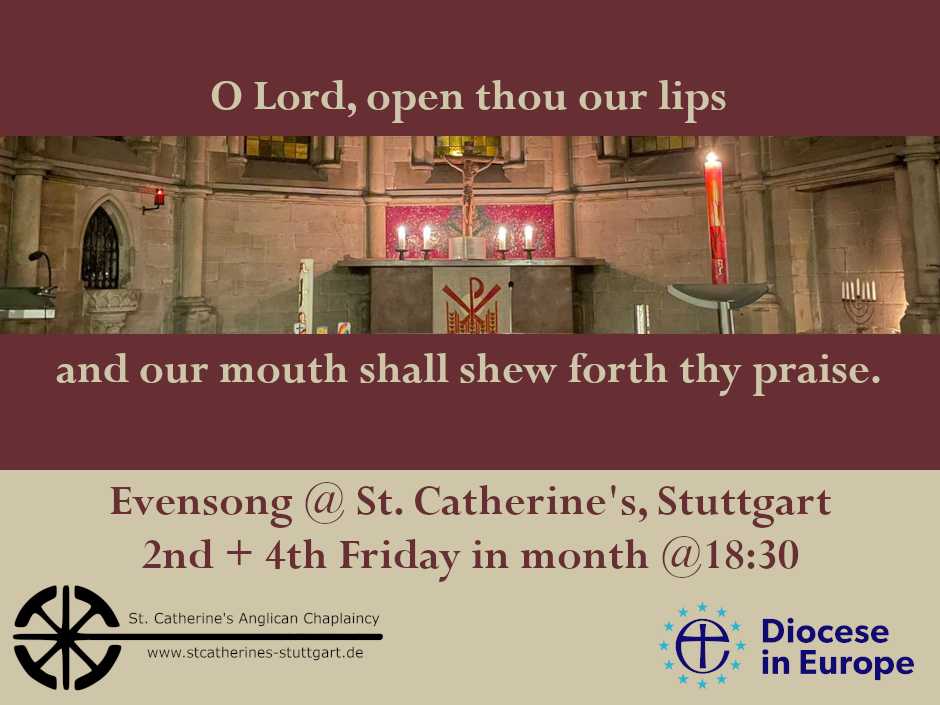A churchwarden is a lay official in a parish or congregation of the Anglican Communion usually working as a part-time volunteer. Holders of these positions are ex officio members of the usually* called (Parochial) Church Council (or in the case of a Cathedral – the Chapter).
*there are regional variations in this and other details and use of terms
Guidance for Church Wardens from the Diocese in Europe
Responsibilities of office
Churchwardens have a duty to represent the laity and co-operate with the incumbent (or, in cases of vacancy, the bishop). They are expected to lead the parishioners / church members by setting a good example and encouraging unity and peace. They have a duty to maintain order and peace in the church and churchyard at all times, and especially during services, although this task tends to be devolved to sidesmen (welcome team).
Churchwardens in many parts of the Anglican Communion are legally responsible for all the property and movable goods belonging to a (parish) church. If so, they have a duty under ecclesiastical law to keep an up-to-date inventory of the valuables, and if applicable a “terrier of the property” (map of any land owned some of which may be let). Whenever churchwardens authorise work on the church building having obtained a faculty or to carry out work recommended in the church’s Quinquennial Inspection Report, they must record this in the Church Logbook; it is inspected with the inventory. The churchwardens must ensure these logs are ready for inspection in case of a visitation and for periodic inspections.
Priests and their equivalent tend to devolve day-to-day maintenance of church buildings and contents to their churchwardens.
If an incumbency is vacant, the bishop (or the Archdeacon acting on his or her behalf) will usually appoint the churchwardens as sequestrators of the parish until the bishop appoints a new incumbent. The sequestrators ensure that a minimum number of church services continue to be held in the parish, and in particular that the Eucharist continues to be celebrated every Sunday and on every Principal Feast. They tend do this by organising a regular rota of a few volunteer clergy from amongst either Associate Ministers / PTOs (MSE or SSM)* from within that diocese or retired clergy living in or near the parish / church. The bishop will tend to consult the churchwardens before appointing a new priest to take over the parish / church / chaplaincy; in Church of England (including Europe diocese) there is a set process to follow which also involves representatives of the congregation.
Churchwardens’ duties may vary with the customs of the parish or congregation or chaplaincy, the canons of the diocese to which the parish / church / chaplaincy belongs, the desires of the priest, and the direction of the parish board / church council or the congregation as a whole. A definition of their duties is that they are “ultimately responsible for almost everything in a church which does not have to be done by a priest. If the churchwarden does not do it himself, then he is responsible for making sure that it is done by someone”.
* PTO = permission to officiate (at St Catherine’s that includes Wolfgang and Julie and Brigitte and Solomon) MSE = Minister in Secular Employment (Howard) SSE = Self Supporting Minister (Solomon)
Responsibilities
In England dioceses, churchwardens have specific powers to enable them to keep the peace in churchyards.
The following are punishable with a £200 fine:
• riotous, violent, or indecent behaviour in any cathedral church, parish or district church or chapel of the Church of England or in any churchyard or burial ground (whether during a service or at any other time)
• molesting, disturbing, vexing, or troubling, or by any other unlawful means disquieting or misusing:
o any preacher duly authorised to preach therein, or
o any clergyman in holy orders ministering or celebrating any sacrament, or any divine service, rite, or office, in any cathedral, church, or chapel, or in any churchyard or burial ground.
The churchwarden of the parish or place where the offence was committed may apprehend a person committing such an offence, and take them before a magistrates’ court. In practice this means they should be aware of these offences and may be expected to conduct a citizen’s arrest until police arrive, if appropriate. Until 2003, the offence was punishable by up to two months’ imprisonment. However, caution is advised in the use of this power.
In the absence of a PCC Treasurer, the churchwardens must fulfil the role of Treasurer together.
In the absence of a Safeguarding Officer this responsibility also devolves to the Wardens.
Types of Churchwarden
Historically, there are two main types of warden: the people’s warden(s) (and assistants, if any) are elected annually by the congregation as a whole (at what is called the Annual Vestry Meeting or “meeting of the parishioners”); the priest’s warden(s) (and assistants, if any), are appointed by the incumbent. However, this distinction has been abolished in several areas of the Anglican Communion in favour of both wardens being appointed jointly (notably in Church of England, although the incumbent retains the right in some circumstances to appoint one warden).
In some jurisdictions (but not in England) where a parish temporarily has no priest, is not self-supporting, or in which the parish board has been dissolved, wardens are appointed directly by the bishop and are called “bishop’s wardens”.
The only areas in which wardens almost always have no authority, often proscribed by canon, are music and liturgy, which are considered to be under the exclusive authority of the priest or bishop in charge of the parish. Nevertheless, in the Church of England churchwardens have authority to officiate at Morning and Evening Prayer if a priest or licensed lay person is unavailable.
Authority of Churchwarden
In the Church of England, churchwardens are officers of the parish and officers of the bishop. Each parish / church / chaplaincy elects two churchwardens annually (unless an existing custom in place on 1 January 2002, and which has continued since before 1 January 1925, states otherwise) and they are elected on or before 30 April and are sworn in between being elected and 31 July the same year. Churchwardens are (re-)elected annually at the Annual (Parochial) Church Meeting and can serve a maximum of six years followed by a two-year break unless the rule is previously suspended by the Annual (Parochial) Church Meeting.
Some churches may appoint assistant wardens to help them. These are distinct from Deputy Churchwardens who have a precise role in certain limited cases. The terms “Honorary Churchwarden” or “Churchwarden Emeritus” are sometimes bestowed on retiring churchwardens; these are purely honorary terms and do not allow such a holder to continue to sit unelected on the (P)CC.
Churchwarden’s ‘Staff’
As you enter many / most Church of England churches and walk down the aisle, you will notice two tall staves fixed to the end of the pews. One has a symbol of a bishop’s mitre and the other has a crown. They are known as ‘finials’. These are the symbols of office of the Parish Wardens. The one with a mitre is the Priest’s Warden (appointed) and the other is for the Peoples’ Warden (elected).
These wands go back to the earliest days of the Anglican Church. It is reminder that Wardens are not just administrators and book-keepers. With the priest, they share a responsibility of the spiritual welfare of the parish. For that reason, they are kept in the church and not in the parish office. On important occasions, the Wardens, on behalf of the congregation, bear these symbols when they welcome the Archbishop or Regional Bishop when they enter the church for worship. They are also used in the entry processions on major festivals: Christmas, Easter, Pentecost, Patronal festivals, Confirmations and other Bishop’s visits. These signs of office are presented to the Wardens when they appointed and elected after an A(P)CM. So, the primary function is liturgical, and are a healthy reminder that the work of lay leaders is as important as that of the priest.
In years past they had another function, to jab parishioners who had fallen asleep during a sermon! Bear in mind that sermons in those days often went on for an hour!











